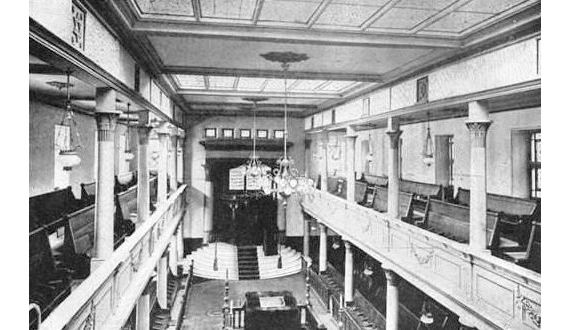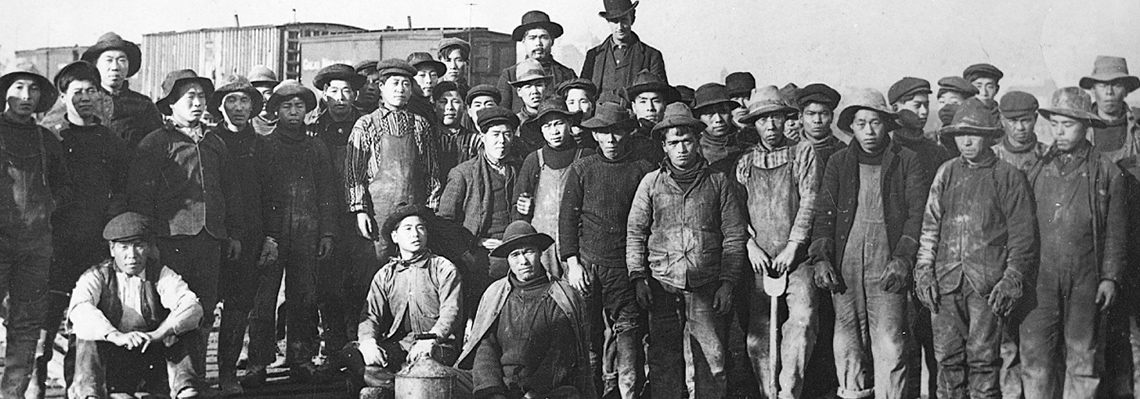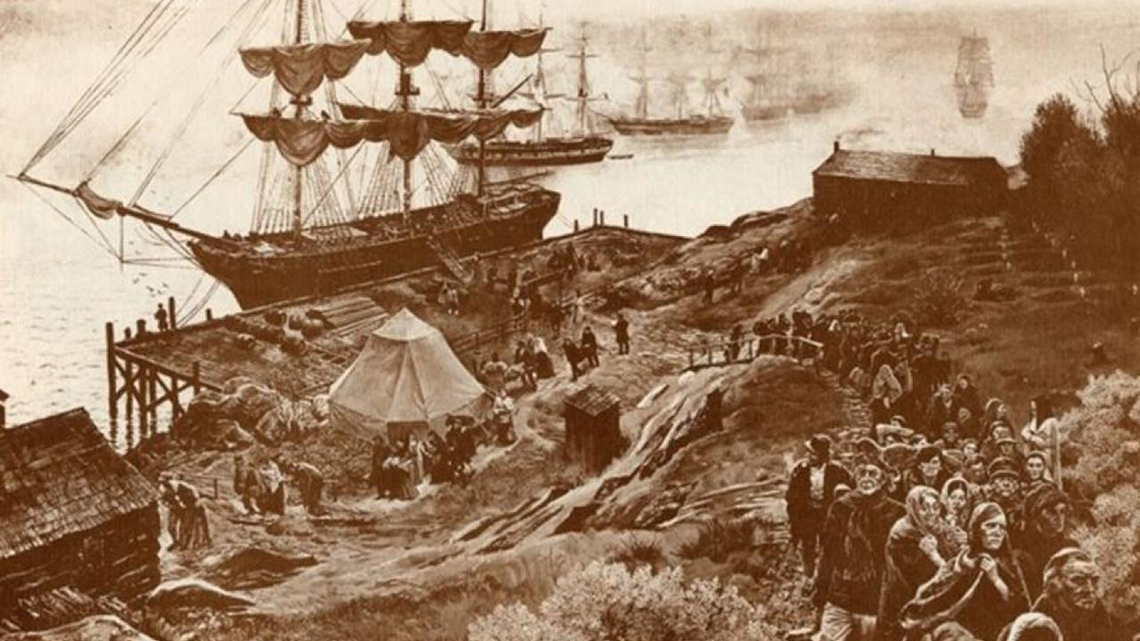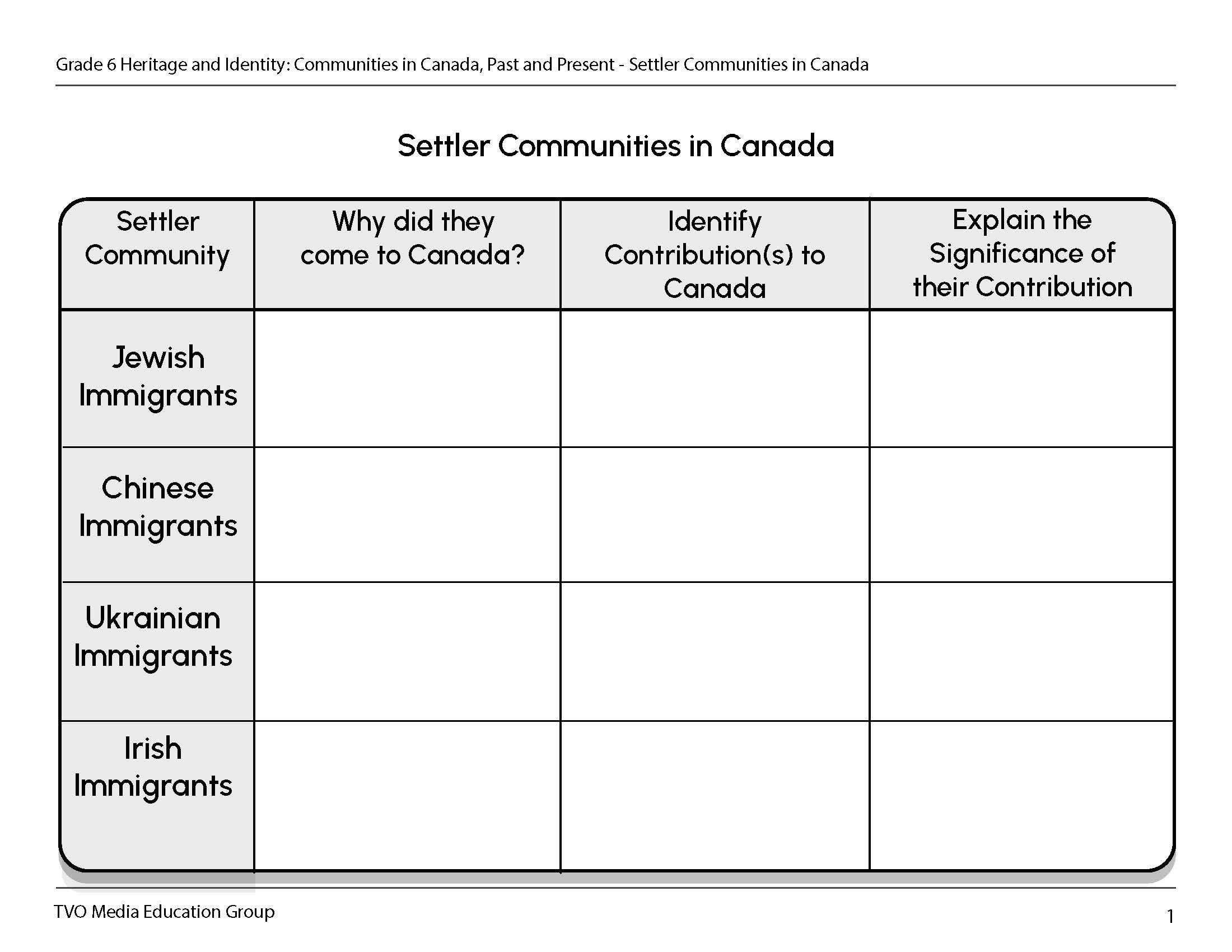Minds On
Diversity

One significant part of Canadian identity is the diversity of the country. What is diversity?
Press ‘Definition’ to access what diversity means.
For hundreds of years, individuals, families, and groups have been leaving their home countries and migrating to Canada. What do you already know about the communities that have come to Canada in the past and in the present?
Explore the KWL Chart – Diversity in Canada. Complete the K and W of the chart about diversity and how it relates to Canadian identity in your notebook or use the following fillable activity document.
K - What is something you already know about diversity or the development of Canada’s identity?
W - What is something you are wondering about related to how settler communities (those who came to Canada in the past or the present) contribute to the development of Canada’s identity?
You will get to complete the L section of the chart after you explore the following video about newcomers to Canada.
Press the ‘Activity’ button to access the KWL Chart – Diversity in Canada.
Let’s learn about newcomers to Canada
As you explore the following video, complete the row for L – What is something you learned about how different settler communities arriving in Canada contribute to the development of Canada’s identify?
Here is the chart that you have used before to complete the K and W sections. Use it this time to respond to the L section.
Press the ‘Activity’ button to access the KWL Chart – Diversity in Canada.
Action
The impact of settler communities on Indigenous communities

Canada is a diverse country with many different ethnic and cultural groups now calling it their home. Toronto, which is the capital city of the province of Ontario, is one of the most multicultural cities in the world. Over 140 different languages are spoken there. As you learn more about Canada, it is important to acknowledge that Canada was not “found/discovered” by European explorers, as it has been home to Indigenous Peoples since time immemorial, or as long as can be remembered.
When European colonizers first arrived in North America, they saw valuable resources that could be taken from the land. Despite the First Nations communities who were living and thriving with their own distinct cultures, languages, and ways of knowing, the King of France claimed the land. He created a colony, using the land for money and forcing the First Nations communities to adapt to the French language, laws, and cultural values. The King of France also encouraged people from France to move to what is now known as Québec, previously called the colony of New France.
After the French came to Canada, the British soon arrived and created their own English colonies.
Press ‘Definition of A Colony’ to access its meaning.
Brainstorm
Brainstorm
In what ways would the arrival of European colonizers and the removal of resources from the land impact the Indigenous communities who were already living in that area?
Did the settler communities and the Indigenous communities living on this land benefit from the actions of the King of France in the same way? Why or why not?
Respond using a method of your choice.
When you are ready, press the ‘Answer’ button to reveal a possible answer.
New settler communities

As more settlers arrived in Canada, which was then called British North America, more Indigenous Peoples were forcibly removed from their lands, and their traditional activities such as hunting, fishing, and trapping were severely impacted. A growing population also created a need for more things like railroads, canals, and farmland to support the new communities. A combination of reasons like fleeing harm in their home country and seeking new opportunities brought people to British North America. Some of these communities, including Chinese, Irish, and Jewish people, made significant contributions to the development of British North America. It is important to acknowledge that although settler communities were coming to the lands for many different reasons, they were displacing Indigenous Peoples from their homelands and changing their way of life.
Press ‘Significance’ to access what is meant by significant contributions.
Significant events include those that resulted in a great change–positive or negative–over long periods of time for large numbers of people. Significance depends upon one’s perspective and purpose. What might be considered significant to one group of people might not be considered significant to others. The new settler communities helped to shape and strengthen the rural communities and build the economy of British North America/Canada.
Economy refers to the production and consumption of various goods and services in a country, region, or community.
Reading Time
New settler communities
Explore and use the following information provided for each settler community to complete the activity.
Press the following tabs to learn more about the various new settler communities.
Before 1760, French settlers banned Jewish people from moving to New France. When the British settlers took over New France, the first Jewish immigrants, Samuel Jacobs and Aaron Hart, settled in Québec because they were a part of the British army. In 1768, Aaron Hart’s children helped create Canada’s first synagogue in Montréal.
The Spanish & Portuguese Synagogue of Montréal (which was called the Shearith Israel) started with just 15-20 Jewish people gathering to pray in a space they rented. In 1777, they were able to build the Jewish community synagogue of their own. Today, the synagogue has over 800 families who gather and worship. It is an important part of their community for gathering, learning, and connecting with each other.

During the 1800s, Guangdong province, China experienced natural disasters like typhoons (hurricanes), droughts, earthquakes, and floods, as well as civil wars. Young men in search of work in the new industries in British North America left their homes in China to make a new life. Gold was being discovered in what is now British Columbia, so many came in hopes of finding some.
In 1880, Canada decided, without the consent of Indigenous Peoples, to build a railway to connect British Colombia to the rest of the country. This was called the Canadian Pacific Railway and displaced many Indigenous communities as a result. The people building the railroad contacted agencies in Guangdong province for Chinese workers. They also got Chinese workers who had previously built the railway in California to come to British Columbia.
About 7,000 Chinese workers, along with other workers, built the railroad. Despite their extremely hard work, Chinese workers were often paid less. This work was dangerous, and it is estimated that between 600 and 2,200 men died while constructing this railway. After the railway was built, the Chinese workers were often not recognized by the Canadian government for the important role they played in building it. In the image, take note of what the Chinese workers are wearing and the condition of their clothing.

Three hundred Irish settlers first came to Halifax in British North America in the 1760s when it was advertised that there was the opportunity to farm large pieces of land and that there was a need for mechanics. In 1823, another group of Irish immigrants settled in Peterborough. Each household was given a cow, three bushels of potato seed, and whatever basics they needed to get started. By 1831, there were 34,000 people of Irish descent in British North America, helping to shape the rural areas of Ontario and build the economy.
From 1845 to 1852, Ireland was hit by a potato famine, meaning that a fungus affected the potatoes, which led to starvation and the death of over a million people. Hundreds of thousands of people needed to find a way to leave Ireland for their health, so thousands came to Canada. Irish immigrants were one of the main groups who built the Lachine Canal in Montréal, Québec. Without the Lachine Canal, Montréal wouldn’t have been able to establish itself as a manufacturing hub.

After exploring the information about the settler communities that came to Canada, complete the Settler Communities in Canada Activity in your notebook or use the following fillable activity document.

Press the Activity button to access the Settler Communities in Canada Activity.
Activity(Opens in a new tab)When you are ready, press the ‘Answer Guide’ button to check your understanding.
| Settler Community | Why did they come to Canada? | Identify Contribution(s) to Canada | Explain the Significance of their Contribution(s) |
|---|---|---|---|
| Jewish Immigrants | The first Jewish immigrants came to Canada as part of the British army. | They built Canada’s first synagogue in Montréal, which created a space for the Jewish community to gather and worship. | They helped establish Montréal’s vibrant Jewish community. |
| Chinese Immigrants | Some immigrants came to find gold and others came to work on the railroad. | These men built the railroad for Canada. | They were excellent workers, but the work was dangerous, so many died. They were not given the recognition they deserved. |
| Irish Immigrants | Thousands came to British North America due to the potato famine. | They farmed land and became mechanics. | They helped shape and strengthen rural communities and build the economy of British North America. |
Impact on Canadian life
In addition to the contributions settler communities have made to the development of Canada, they have also impacted daily life with aspects of their own identity, including language, religion, and cultural practices.
Let’s explore examples of how parts of Jewish and Chinese identities have impacted ways of life in Canada.
Pause and Reflect
Pause and reflect
What is one example of how Chinese and Jewish identity helped shape the development of Canada?
What might have been an impact on each community’s identity upon arrival in Canada?
Record your thoughts in a notebook or a method of your choice.
When you are ready, press the ‘Answer’ button to reveal a possible response.
Consolidation
Settler life in Canada
The early settlers who came to Canada influenced the development of Canada. They impacted Canada through their land ownership policies, music, food, religion, and dance.
Choose one of the following topics about aspects of settler influence on Canadian identity to research more about and complete the 3-2-1 graphic organizer, where you will:
- record three facts you learned from your research on the topic
- share two visuals or media resources (images, charts, graphs, infographics, artefacts, videos, audio clips) that connect to your research on the topic
- share one opinion about the impact of the settler influence on the Indigenous communities already living on the land and on Canadian Identity
You may choose how you wish to present this research (for example, in a written/typed paragraph, as an audio recording, using a mind map, etc.) or use the graphic organizer provided.
Possible topic choices:

- French settlers and land ownership practices
- Irish settlers and folk music in Atlantic Canada
- British settlers and religion
Complete the 3 – 2 – 1 Graphic Organizer in your notebook or using the following fillable activity document.
Be prepared to share your work, either out loud, as a video/audio clip, or using another method of your choice.
Reflection
As you read through these descriptions, which sentence best describes how you are feeling about your understanding of this learning activity? Press the button that is beside this sentence.
I feel...
Now, record your ideas using a voice recorder, speech-to-text, or writing tool.
